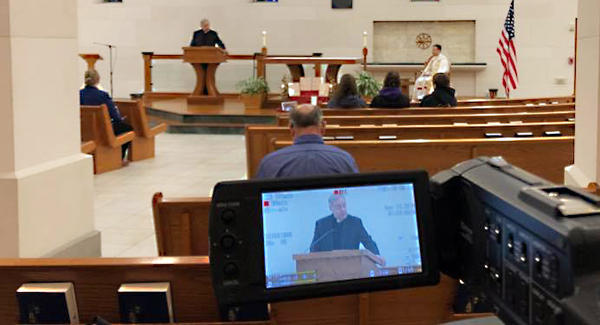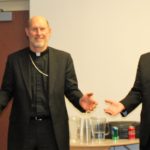
Father George McDaniel gave a talk Nov. 12 on World War I in Christ the King Chapel on the St. Ambrose University campus, Davenport.
For The Catholic Messenger
DAVENPORT — Two historians gave talks at St. Ambrose University in Davenport to commemorate the 100th anniversary of the World War I Armistice. Father George McDaniel, professor emeritus of St. Ambrose University, and George Eaton, the U.S. Army Sustainment Command historian of the Rock Island Arsenal in Illinois, spoke Nov. 12 in Christ the King Chapel on campus.
The centennial recognized the day in 1918 (Nov. 11) when the Armistice was signed between the Allies and Germany to cease hostilities on the western front of WWI. During the event, the chapel bell tolled 16 times to recognize the 16 million people who died in the war. St. Ambrose University student Rachel Wiedman performed Taps.
Fr. McDaniel set the scene in his talk. “It began with the assassination in Sarajevo of the heir to the Austro-Hungarian throne and his wife on June 28, 1914. Five weeks later all of Europe was engaged in a war to defend national honor and dynastic rights. President Woodrow Wilson declared that the United States would be neutral in thought and deed, but eventually the country would also be drawn into the war.
“Ambrosians watched the war in Europe with interest but went about their lives on campus. After the first winter of 1914-15 when the casualties were mounting, Ambrosians followed the wishes of Pope Benedict XV and observed ‘Peace Sunday’ with High Mass. The chapel was ‘thronged’ all day with students praying before the Blessed Sacrament to the Prince of Peace.” Movie nights, a regular feature of campus life, included newsreels of scenes from the battlefields. A few Ambrosians were members of the Iowa National Guard but most students were not in uniform.
As the class of 1916 prepared to graduate, the United States was beginning preparations for a possible entry into the war. “The commencement speaker that year spoke about the ‘millions of devoted men’ who were already battling for the ideal of patriotism in Europe, ‘enduring hunger, heat and cold, pain and death,’ without complaint.” The speaker sought to convince his listeners of the virtues of making a similar sacrifice. If they were “‘upright, faithful until death,’ the world would admire them and St. Ambrose College would receive ‘added luster from your many lives and Christian virtues.’ Before the war ended, over 200 Ambrosians would be in uniform, some of whose ‘young blood’ would be shed on the battlefield.
“Finally, on April 2, 1917, President Wilson appeared before a joint session of Congress and asked for a declaration of war to make the ‘world safe for democracy.’ Within the next few days both houses of Congress voted to declare war….”
While the students were on Easter break, war was declared. When they returned to St. Ambrose, their president, Father William Hannon, called a special assembly. He told the students to show their loyalty to the country and urged them to follow closely the events in Europe. Two weeks later students formed a cadet corps; 125 students of military age pledged to be a part of military training until they graduated. They held regular drills and a rifle shooting gallery, located on top of the new gymnasium, received regular use.
“‘The students looked forward to hearing from their former colleagues who were now in uniform and occasionally one would visit campus. The Sodality of Mary, a student prayer group, made their prayer intention for the year the ‘return of men to the True Faith, for our soldiers at the front and for an early and victorious end of the war.’
“Students were not the only ones in uniform. The football coach, George Jones, had enlisted and served in France. Other faculty members in the service included Father Francis Barry, Edwin Bashe and Bernard Marron. The students who remained at home contributed to the war effort by purchasing war bonds. The school also complied with the guidelines of Herbert Hoover’s Food Administration. One goal was to get Americans to not eat beef or pork so that it could be used to feed the troops. The menu in the cafeteria changed and the students coped with the changes….
“By the fall of 1918, Americans had arrived in the front lines in huge numbers and there were rumors that the war could be ending. At the same time, however, another killer was stalking the fields of Europe and the streets of cities around the world, and the halls of St. Ambrose: Spanish influenza.” For students’ protection, the school was closed Oct. 16.
“The war ended with the Armistice at 11 a.m., on Nov. 11, 1918. That was 2 a.m. in Davenport but factory whistles blew and church bells rang all over town. But St. Ambrose had not resumed classes because of the epidemic.”
“The war had exacted a huge price in human lives,” Fr. McDaniel continued. “About 10 million combatants died of battlefield deaths and disease. Two hundred and twenty-three Ambrosians served in uniform and seven died. An estimated 100 million people died around the world from the influenza pandemic.
The war changed almost everything they had known,” Fr. McDaniel said.
“….Armistice Day 1919, the first anniversary of the end of the war, was observed on campus. Classes ended just before 11 and the campus community assembled for a prayer service. President Hannon told them they should be grateful to God for the sacrifices made by the men and women who served, including their classmates and friends.” He urged them to study hard so they would be prepared in the event a crisis arose in the future. In closing he said, ‘America, then, is a precious heritage, won and kept for us by those who have gone before us. What are we going to do and what are we doing now to keep it safe for ourselves and those who will come after us?’
Eaton spoke about the Rock Island Arsenal’s role during WWI and about the eight WWI veterans interred in the city cemetery. “On this 100th anniversary of the end of World War I, I ask you to think about how our veterans from every war struggled when they got home and how they continue to struggle. That struggle also impacts their families and all around them. Take a moment to remember and become more aware of the long-term impact of war on all our veterans.”










